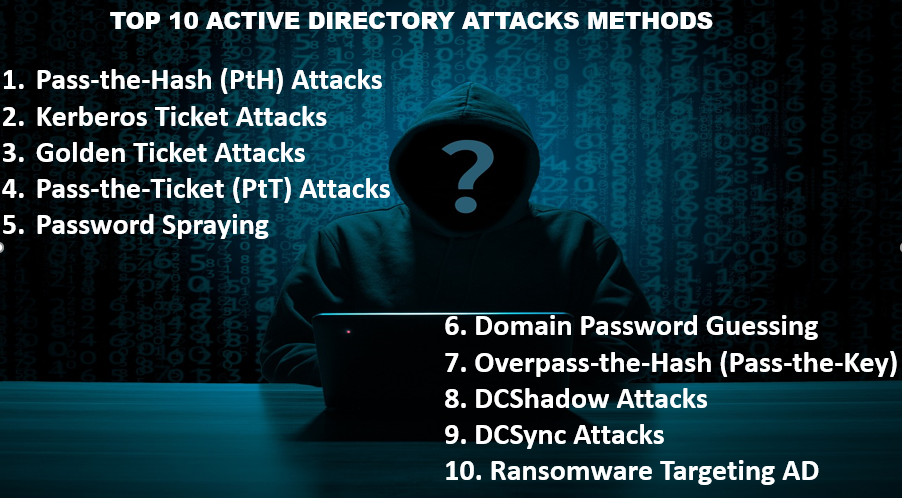In today’s interconnected world, where data is the lifeblood of organizations, securing your network infrastructure is paramount. Active Directory (AD) is the linchpin of network management, making it a prime target for cyber adversaries. To ensure your organization’s digital fortress remains impervious to attack, we dive deep into the top 10 Active Directory attacks, their intricate processes, workflows, and effective countermeasures.

Table of Contents
List of Top 10 Active Directory Attacks
Pass-the-Hash (PtH) Attacks
Attack Process:
1. Hash Capture:
Attackers gain access to a compromised system or network.
They use various techniques such as malware, password-cracking tools, or privilege escalation to obtain the hashed passwords stored on the system.
2. Hash Manipulation:
Once they have the hashed passwords, attackers utilize tools like Mimikatz to extract plaintext passwords from the hashes.
Mimikatz, for example, can exploit vulnerabilities in the Windows authentication process to reveal these passwords.
3. Unauthorized Access:
Armed with the extracted plaintext passwords, attackers can impersonate legitimate users and access other systems, moving laterally across the network.
Since they possess valid credentials, these attacks can be challenging to detect.
Countermeasures:
1. Credential Guard:
Implement Microsoft Credential Guard on Windows systems to protect against hash dumping.
Credential Guard isolates the credentials in a secure container, preventing attackers from accessing them.
2. Regular Password Changes:
Encourage users to change passwords frequently, making stolen hashes less valuable over time.
Implement password policies that enforce password changes at regular intervals.
3. Network Segmentation:
Divide the network into segments or zones, limiting lateral movement for attackers.
Restrict access to sensitive systems and resources through strict access control.
Kerberos Ticket Attacks
Attack Process:
1. Ticket Theft:
Attackers aim to steal Kerberos tickets from a compromised system.
They may employ techniques like Pass-the-Ticket (PtT) attacks, where they capture the tickets stored on a target system.
2. Ticket cracking:
Once the tickets are stolen, attackers attempt to crack the encryption used in these tickets.
This process aims to reveal the plaintext password associated with the stolen tickets.
3. Unauthorized Access:
With the plaintext password at hand, attackers can use it to gain access to the target account or service.
This unauthorized access can compromise critical network resources.
Countermeasures:
1. Account Lockout Policies:
Implement account lockout mechanisms that temporarily lock accounts after a certain number of failed login attempts.
This deters attackers from attempting to steal tickets.
2. Strong Encryption:
Enforce the use of AES encryption for Kerberos tickets, making it significantly harder for attackers to crack the tickets.
Disable weaker encryption algorithms.
3. Monitoring:
Continuously monitor logs for suspicious activity related to Kerberos ticket usage, such as repeated failed authentication attempts.
Golden Ticket Attacks
Attack Process:
1. Ticket Fabrication:
Attackers acquire the Key Distribution Center (KDC) service account’s password hash.
They forge their own Kerberos tickets, including the highly privileged Ticket Granting Ticket (TGT).
These forged tickets grant them unlimited, long-term access to AD resources.
2. Persistence:
The forged golden tickets remain valid until their expiration, allowing attackers to maintain persistent access without further compromise.
This persistence makes detection and removal challenging.
Countermeasures:
1. Time Restrictions:
Limit the validity period of Kerberos tickets, including TGTs, to minimize the impact of compromised golden tickets.
Shorter ticket lifetimes reduce the window of opportunity for attackers.
2. Principle of Least Privilege (PoLP):
Implement PoLP to restrict the actions that can be performed with a golden ticket.
Limit the scope and impact of privileged accounts.
3. Audit Trails:
Maintain detailed logs that track the creation and usage of Kerberos tickets.
Regularly review these logs to detect anomalous ticket creation.
Pass-the-Ticket (PtT) Attacks
Attack Process:
1. Ticket Theft:
Attackers steal legitimate Kerberos tickets, often by compromising user accounts or exploiting vulnerabilities.
These tickets may be obtained through PtT attacks, where attackers capture and reuse existing tickets.
2. Unauthorized Access:
By presenting stolen tickets during authentication, attackers gain unauthorized access to systems or services.
They can move laterally within the network, posing a significant security risk.
Countermeasures:
1. Ticket Encryption:
Encrypt Kerberos tickets to protect them from interception during theft.
Utilize strong encryption algorithms for tickets.
2. Isolate Compromised Accounts:
If a PtT attack is detected, immediately isolate the compromised accounts to prevent further exploitation using stolen tickets.
Change the passwords associated with compromised accounts.
3. Regular Password Changes:
Implement frequent password changes for all accounts to render stolen tickets useless over time.
Password Spraying
Attack Process:
1. Password Guessing:
Attackers select a limited set of common passwords or dictionary words.
Instead of attempting numerous login attempts for a single account, they try different usernames with these passwords to remain stealthy.
2. Low and Slow:
Attackers avoid rapid and numerous login attempts to evade account lockout policies.
They may space out login attempts over an extended period, making detection more challenging.
Certainly, here are the details of the remaining five Active Directory attacks:
Countermeasures:
1. Account Lockout Policies:
Implement account lockout policies that temporarily lock accounts after a specific number of failed login attempts.
This deters password-spray attacks.
2. Complex Password Policies:
Enforce strong, complex password policies for all user accounts.
Require passwords to contain a mix of upper- and lower-case letters, numbers, and special characters.
3. Monitoring:
Continuously monitor login attempts for patterns indicative of password spraying.
Implement alerting mechanisms to respond quickly to suspicious activity.
Domain Password Guessing
Attack Process:
1. Brute Force:
Attackers systematically guess passwords for AD accounts, often using automated tools.
They may target specific user accounts or try a list of common passwords across multiple accounts.
2. Persistence:
Successful guesses grant attackers unauthorized access to AD user accounts.
They can potentially escalate their privileges and move laterally across the network.
Countermeasures:
1. Account Lockout Policies:
Implement account lockout policies to temporarily lock accounts after a specified number of failed login attempts.
This discourages attackers from attempting brute-force attacks.
2. Password Policies:
Enforce strong and complex password policies, requiring users to create passwords with a combination of uppercase and lowercase letters, numbers, and special characters.
Regularly prompt users to change passwords to thwart guessing attempts.
3. Monitoring:
Continuously monitor login attempts, especially failed attempts, for patterns indicative of brute force attacks.
Implement alerting mechanisms to respond promptly to suspicious activity.
Overpass-the-Hash (Pass-the-Key) Attacks
Attack Process:
1. Escalation:
Attackers aim to gain control over privileged accounts or systems.
They may exploit vulnerabilities or compromise service accounts.
2. Elevation of Privilege:
Once control is established, attackers escalate their access privileges within AD.
This enables them to perform actions typically reserved for administrators.
Countermeasures:
1. Regular Privilege Audits:
Routinely review and restrict the privileges assigned to accounts and systems.
Identify and remove unnecessary privileges to limit the attack surface.
2. Principle of Least Privilege (PoLP):
Implement PoLP, ensuring that users and systems have only the minimum permissions necessary to perform their tasks.
Limit the potential impact of compromised accounts.
3. Multi-Factor Authentication (MFA):
Require multi-factor authentication for critical actions, making it harder for attackers to escalate their privileges even if they gain initial access.
DCShadow Attacks
Attack Process:
1. Manipulating Replication:
Attackers manipulate AD replication by injecting malicious data into the replication process.
They may impersonate a Domain Controller (DC) or use stolen credentials to initiate changes.
2. Unauthorized Changes:
Manipulating replication allows attackers to make unauthorized changes to AD objects, including the addition of backdoors or new accounts.
These changes may go unnoticed for extended periods.
Countermeasures:
1. Monitor Replication Traffic:
Regularly review Active Directory replication logs to detect any unusual or unauthorized replication activity.
Pay special attention to changes in replication patterns.
2. Change Tracking:
Enable change tracking mechanisms in Active Directory to keep a record of changes made to AD objects.
This helps identify unauthorized modifications quickly.
3. Restrict Replication Rights:
Limit the rights to initiate replication to trusted administrators only.
prevent unauthorized entities from initiating replication, reducing the risk of DCShadow attacks.
DCSync Attacks
Attack Process:
1. Credential Theft:
Attackers use tools like Mimikatz to steal credential data, particularly the NTLM hashes of AD accounts.
These tools can access and replicate these credentials, often using Domain Administrator privileges.
2. Domain Control:
Attackers use the stolen credentials to impersonate Domain Controllers (DCs).
They initiate the DRSUAPI protocol to synchronize AD data, effectively “syncing” with AD and obtaining sensitive data, including password hashes.
1. Credential Guard:
Implement Microsoft Credential Guard to protect against credential theft.
Credential Guard isolates and protects sensitive credential data.
2. Regular Monitoring:
Continuously monitor for suspicious activity, particularly any attempts to access sensitive systems or initiate DRSUAPI synchronization.
Promptly investigate and respond to anomalies.
3. Principle of Least Privilege:
Implementing the principle of least privilege is essential to restricting access to confidential information and data.
Restrict the accounts that have permissions to perform DRSUAPI synchronization.
Ransomware Targeting AD
Attack Process:
1. Infiltration:
Ransomware infiltrates the network through various means, such as malicious email attachments or compromised software updates.
Once inside, it seeks to escalate privileges and gain control over the network.
2. Extortion:
After gaining control, attackers encrypt AD and data, rendering them inaccessible.
They demand a ransom payment in exchange for decryption keys, often in cryptocurrencies.
Countermeasures:
1. Regular Backups:
Maintain offline backups of critical AD data and other important files.
These backups should be isolated from the network to prevent ransomware from encrypting them.
2. Network segmentation:
Isolate Active Directory from other network segments to contain the spread of ransomware.
Restrict access to AD resources to authorized personnel only.
3. Security patching:
Keep all systems and software up-to-date with the latest security patches to close vulnerabilities that ransomware might exploit.
Regularly apply security updates to mitigate risks.
You can follow us on LinkedIn and Twitter for Cloud & Cybersecurity updates.


You completed a number of nice points there. I did a search on the issue and found nearly all people will have the same opinion with your blog.
Hi there, I found your website via Google while searching for a related topic, your website came up, it looks great. I have bookmarked it in my google bookmarks.